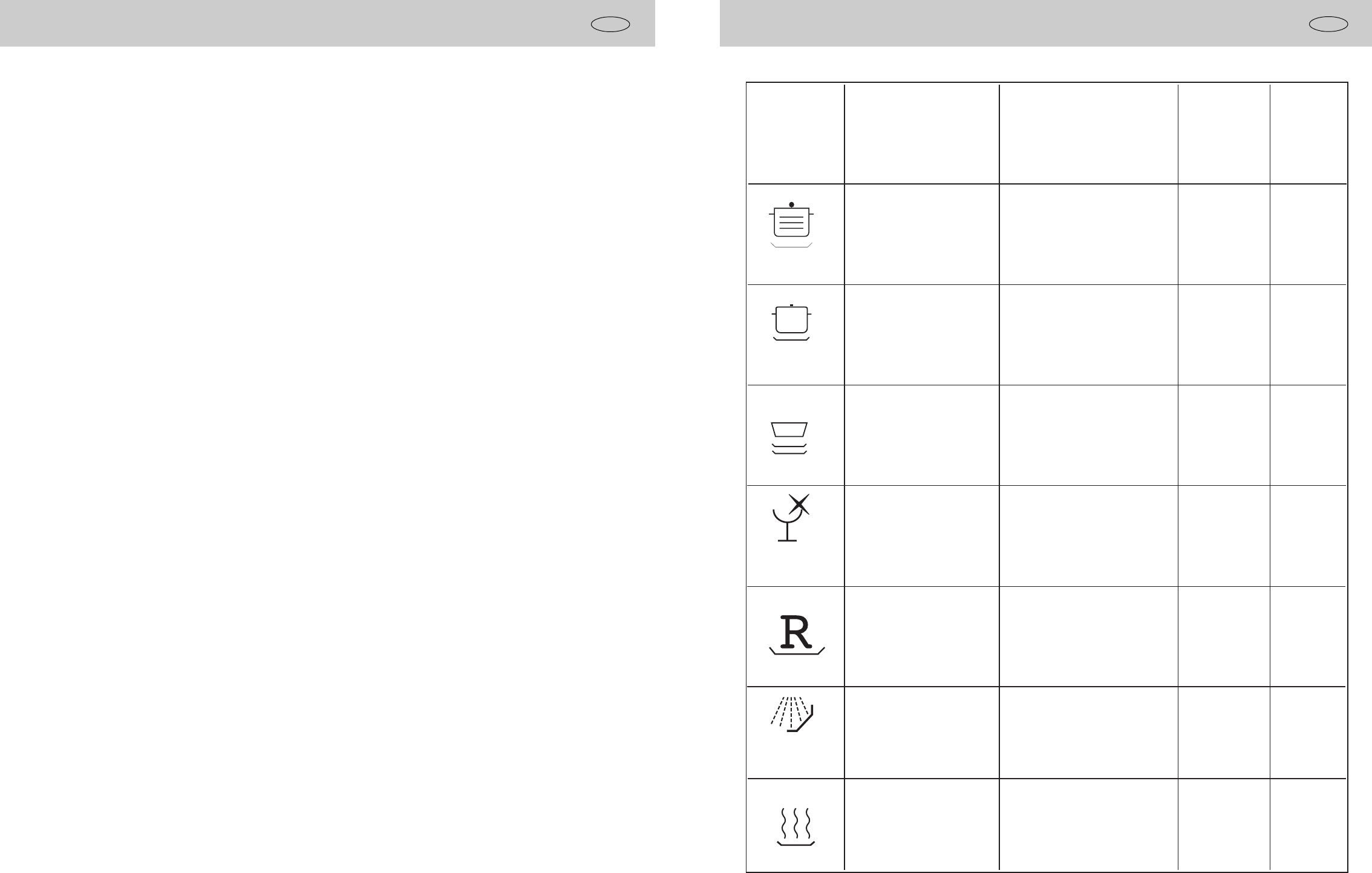
.5.
GB
.6.
GB
Starting the Appliance
Starting a wash cycle
After having completed all of the installation steps in the preced-
ing paragraphs, turn on the water to the unit, partially open the
door of the dishwasher, and press the ON-OFF button "A" lo-
cated on the control panel. The "B" indicator light will come on.
At this point, the appliance is on and ready to be programmed.
Setting and Starting a wash Cycle
Choose the desired cycle by pressing the cycle selection button
"P". Each time it is pressed, one of the cycle indicator lights "J"
will come on in succession.
Choose the wash cycle you feel is most appropriate for the type
of dishes that need washing (consult the wash cycle table con-
tained in this manual, especially when first using the appliance).
Close the door and after a few seconds, the wash cycle has be-
gun and cannot be modified. If necessary, read the paragraph
entitled, "Cancelling or modifying a cycle while underway. "The
end of the cycle will be signalled by a double acoustic sound, and
the indicator light "J" will begin to blink.
Cancelling or modifying a cycle while underway...
Premise: A cycle that is underway can only be modified if it has
only been running for a short time.
Otherwise, the detergent may have already been used, and the
appliance may have already drained the wash water. If this is the
case, the detergent dispenser must be refilled (see the paragraph
entitled, "Loading the Detergent").
To change the cycle currently underway, open the door, the ON-
OFF bution "A". Follow the instructions contained in the para-
graph entitled "Starting a wash cycle...","Setting and starting a
wash cycle".
To set a new wash cycle, follow the instructions contained in the
paragraph entitled, "Setting and Starting a Wash Cycle".
If you forget to load some of the dishes...
The wash cycle can be interrupted by opening the door carefully
(in order to avoid being sprayed by hot water). When the door is
closed again, the cycle will automatically restart at the point where
it left off.
At the end of the wash cycle...
The end of the cycle will be indicated by a double acoustical
signal and the blinking of the "J" indicator light. Open the door,
turn off the appliance using the ON-OFF switch and turn off the
water supply to the unit. Wait a few minutes before removing the
dishes so as to avoid handling them while still hot (when they
are more susceptible to breakage) and to get better drying results.
Setting The Start Delay Time
Open the door of the dishwasher partially. If the "C" button is
pressed (see, Close-up View" Control Panel"). The start time for
the wash cycle can be delayed for 2,4,6,8,10 or 12 hours.
Each time the button is pressed, the "D" light will come on indi-
cating the length of the delay.
After selecting the delay time, the wash cycle can be set, as
explained in "Setting and starting a wash cycle..." There will be a
short acoustic signal, and at this point the delay period will begin
to count down. During this period the delay indicator light (D) will
blink. At the end of the delay time, the indicator will stop blinking
and the cycle will start.
NOTE:
During the delay period, none of the settings can be modified. If
the ON-OFF button "A" located on the contro panel, the door is
opened during the delay period, the clock will stop the countdown.
It will start again when the door has been closed.
Wash Cycle Adjustment Buttons
1/2 Load Button
This button (see" Close-up View-Control Panel", letter "E") makes
it possible to wash dishes using only the upper rack if there are
not enough dishes for a full load, This will allow you to save on
water and electrical energy.
Cycle
Cycle
Selection
Information
Description of
Cycle
Normal Wash
Heavy Duty
Light Wash
Glassware
Rapid Wash
Soak
ERF
Normal dirty dishes,
pots and pans. Stan-
dard daily cycle.
Very dirty dishes,
pots and pans. (Not
to be used with deli-
cate items)
Normal dirty dishes,
pots and pans without
dried on residue.
Economic, fast cycle to
be used for items which
are sensitive to higher.
Run immediately after
dishes are used.
Economic, fast cycle to
be used to on not very
dirty dishes right after
they are used. No dry-
ing cycle.
Pre-wash of dishes,
pots and pans while
waiting for the load to
be completed after the
subsequent meal.
Pre-wash with hot water.
Extended wash at 70K
Rinse with cold water.
Rinse with hot waterK
Drying.
Pre-wash with cold water.
Extended wash at 50.
Rinse with cold water.
Rinse with hot water.
Drying.
Wash at 45.
Rinse with warm water.
Hot rinse.
Drying.
Short wash at 40.
Cold rinse.
Short cold wash to prevent
food residue from drying on
the dishes K
30g
5+25g
15g
15g
Pre-wash with cold water.
Extended wash at 50K
Rinse with cold water.
Rinse with hot waterK
Drying.
30g
Detergent Rinse Aid
The cycle of heat wash-
ing and dry tableware.
Heat washing.
Heat wash
Wash Cycle Table








